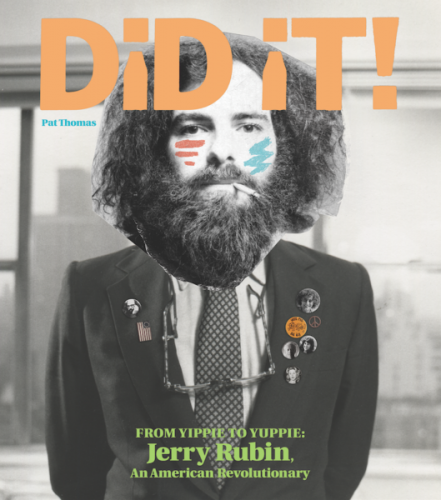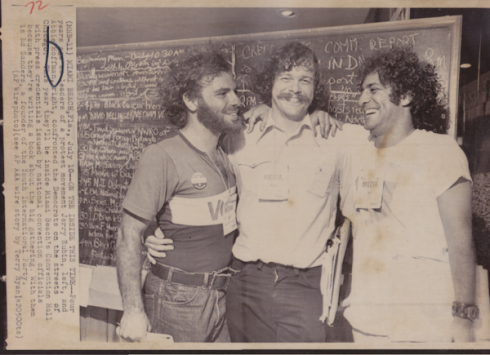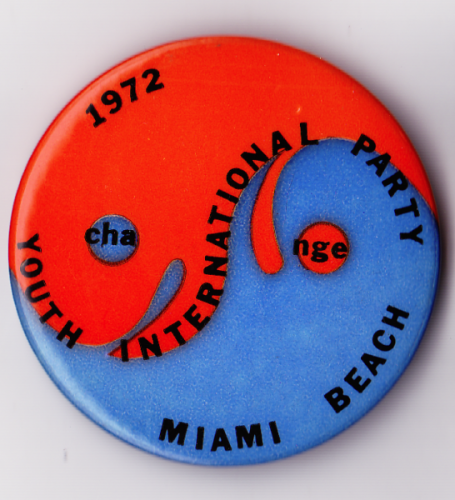Yippies vs. Zippies: New Rubin book reveals ’70s counterculture feud
BY MARY REINHOLZ
The late Yippie leader Jerry Rubin, a onetime West Villager who morphed into an investment banker and died in 1994 after getting struck by a car jaywalking in Westwood, California, comes back to flamboyant afterlife in Pat Thomas’s coffee-table book biography, “Did It!”
Published last year, Thomas’s book offers plenty of photographs of varied gurus and goblins of the counterculture, and sheds light on little-known internecine conflicts among the young politicized hippies who came under scrutiny by federal agents and undercover police for their opposition to the Vietnam War.

The cover of Pat Thomas’s new coffee-table book on Jerry Rubin.
The hefty tome, subtitled, “From Yippie to Yuppie: Jerry Rubin, an American Revolutionary,” recounts how a younger radical group known as the Zippies surfaced before the 1972 Democratic and Republican National Conventions in Miami. The Zippies engaged in fierce feuding with Rubin and Abbie Hoffman, Rubin’s more-famous fellow Yippie prankster and rival. Rubin reportedly regarded the Zippies’ founder, the late Tom Forcade — who ran the Underground Press Syndicate and started High Times magazine — as a provocateur and cop.
Downtown Manhattan street musician David Peel, who died of a heart attack last year at 73, wanted to stay friends with both factions. He states on Page 150 of the book, “Tom Forcade had had an altercation with Jerry Rubin. Very ugly war between Jerry and Tom — who kept changing Yippies to ‘The Zippies.’ Abbie played along with Jerry and we had the Zippies fighting each other, they had a big breakup because it’s all about powerbrokers and it’s all perpetual jealousy.”
Author Thomas, a music producer, reports that the Zippie faction believed that the Yippie leadership had grown old and had “sold out” by endorsing South Dakota Senator George McGovern for the Democratic presidential nomination against Republican incumbent Richard Nixon. Forcade also regarded Rubin and Hoffman as “burned out” after they were convicted and then acquitted as co-defendants in the notorious Chicago 7 conspiracy trial.
In addition, Forcade had a beef with Abbie Hoffman because the Yippie leader refused to pay him $5,000 for work Forcade had done for Hoffman’s bestselling 1971 paperback, “Steal This Book,” according to writer Rex Weiner. Back then, Weiner was a twentysomething Zippie sympathizer and a founder of the short-lived New York Ace underground newspaper. (Disclosure: This transplanted California writer penned a few pieces for the Ace). Weiner even organized what he called a “Counterculture Court” that tried to resolve the money conflict between Hoffman and Forcade.
Weiner said last weekend that the split between the two factions involved a “larger question” in the youth culture concerning the politics of people opposed to Nixon’s regime — whether to work “within the mainstream or become more radical. We were being targeted by the F.B.I.’s COINTELPRO [surveillance] program,” he said. “No one knew anyone to trust anymore. There was a leaflet being circulated in Miami accusing Tom Forcade of being a police agent. Tom definitely wasn’t a cop.”
Tensions were reportedly high when both radical groups showed up in in Miami for the two aforementioned 1972 conventions. The Yippies stayed at the Hotel Albion, a “dumpy” sort of place, while the Zippies camped out in Flamingo Park, staying in tents, recalled Dylan “garbologist” A.J. Weberman in “Did It!”

Sporting press credentials for the Democratic and Republican National Conventions in Miami in 1972, from left, Jerry Rubin, Ed Sanders and Abbie Hoffman.
Weberman, who still considers himself a Zippie, claims in “Did It!” that Forcade and Hoffman got into “physical fights” and that Forcade, back in New York, put out a “contract” on Rubin for calling him a cop.
“Rubin suggested, ‘Well, let’s have a conference in the pizza parlor on Bleecker and MacDougal,’” Weberman is quoted saying in the book. “When he got there, he sat down at this table. And Forcade’s henchman Tim Bloom came in [and] kicked Jerry in the back, and the entire table that was anchored to the wall came loose. After that, Jerry was willing to apologize.”
Author Thomas notes in “Did It!” that Rubin issued a “public apology” to Forcade and other Zippies that appeared in the Oct. 17, 1974, issue of the Village Voice with the headline: “Jerry Rubin: Yip & Karma.” Eventually, according to Weiner, the Zippies took over the Yippie name and banner and started “Yipster Times” at 9 Bleecker Sts. That address was the home for decades of the Yippie headquarters and of New York Yippie leader Dana Beal until the building was sold to a boxing gym in 2014 in forfeiture proceedings. In the last few years before it became a gym, Beal and Co. remade it into the Yippie Museum and Cafe, featuring live comedy and music performances.
Aron Kay, a former East Villager known as the Yippie Pie Man, told this reporter that he became a Zippie after he arrived in New York from California in 1972, noting he traveled to Miami for the two conventions and slept in Flamingo Park. He confirmed Weberman’s account in “Did It!” and also recalled nasty infighting between the Yippies and the Zippies.
“A lot of name-calling went on,” Kay said in a telephone conversation. “People were calling Tom Forcade a cop. Jerry should have known better.”
Kay, now 68, said both he and Weberman had “tagged along” when Forcade’s sidekick Bloom went to the aforementioned pizza parlor — the Pizza Box — “attacked Jerry” and “put the squeeze on him” to apologize to Forcade.
But Kay said he wasn’t present when Weberman went after Yippie eminence Ed Sanders, author and legendary leader of The Fugs rock band in the East Village. Weberman believed that Sanders had called him a cop on a radio show and, in retaliation, said he “trashed” Sanders’s Land Rover outside his Manhattan apartment.
Weberman described the incident vividly in “Did It!” on Page 150: “Meanwhile, Ed Sanders got on the Alex Bennett Radio show and call[ed] me a cop, so we found out where he was living — and trashed his Land Rover. We put sugar in the gas tank but the f—ing sugar wouldn’t go down. We didn’t have any water so I had to piss in the gas tank to get the sugar to go down.”
Speaking to this reporter, he noted, “I could have been arrested for indecent exposure.”
As to why he would do such a thing, Weberman said it was a crazy time.
“Crazy versus crazy,” he said. “Look what happened to Forcade [who killed himself in 1978] and Hoffman [another suicide] and Jerry, who turned himself into road kill.”
Contacted by e-mail, Sanders said of Weberman: “Never called him a cop. And to my knowledge, no sugar or urine in Land Rover, which worked fine up until late 1979.”
Informed of Sanders’s response, Weberman stood by his story. So did “Did It!” author Thomas, who wrote the 2012 book “Listen, Whitey! The Sights and Sounds of Black Power 1965-1975.”
“I believe A.J,” Thomas said. “These [Yippie] guys are very macho and they don’t want to show any vulnerability.”

A Yippie button from the Democratic and National Conventions in 1972.
Thomas said some of the old-time Yips were also complaining about his choice of Rubin for the book instead of Abbie Hoffman. He said the issue arose when satirist Paul Krassner, former editor of The Realist, wrote a review of “Did It!” for the Los Angeles Times in August, and sent it to “Yippies around the country, who said they loved Abbie more. Then they started arguing among themselves.”
Writer Judy Gumbo, widow of Yippie Stew Albert, who was Jerry Rubin’s best friend, said she had heard about the bickering over the book by men in their twilight years and “it turns my stomach. In the Trump era, we don’t need to be bickering among ourselves,” she said, in a conversation from her home in Berkeley.
Gumbo, one of the few original female Yippies, said Rubin and Hoffman had a “Cain and Abel relationship — they loved each other dearly but were ego competitive,” she said. “It was a bromance that had a lot of conflict in it.”
She doesn’t believe Rubin “sold out” to Wall Street, as some of his old cronies think he did.
“It wasn’t as much of a switcheroo as some people think,” she said. “He never was a stockbroker. He was a publicist for what’s been called socially responsible investing.”
Gumbo, who was a fundraiser and vice president of development for the Oregon affiliate of Planned Parenthood when she and Albert lived in Oregon, said she didn’t know about the battles between the Yippies and Zippies. But she went to Miami in 1972 with a women’s group and became aware of paranoia rampant at the Hotel Albion where she and the Yippies stayed, among them Rubin, who was decidedly nervous.
Paranoia was something Gumbo also experienced while living with Albert in the Catskills in 1974. She found an F.B.I. tracking device in their house.
On Sat., March 24, at Unoppressive Non-imperialist Bargain Books, at 34 Carmine St., from 4 p.m. to 5:30 p.m., author Pat Thomas will be in the Village for a book-signing of “Did It! From Yippie to Yuppie: Jerry Rubin, An American Revolutionary.” Paul Krassner will also be live-streamed into the shop to discuss the history of the Yippies and Thomas’s coffee-table book on Rubin. The event is free.
Jim Drougas, the bookstore’s owner, reflected, “I’m a little jealous that we don’t have such a juicy book about Krassner himself or even Abbie or especially Irwin,” referring to his friend the late standup comic “Professor” Irwin Corey. “But it is a nice collection of so much interesting material.”
This appeared in the February 27 issue of The Villager, a weekly newspaper serving Downtown Manhattan, New York. Here is a link to the original.
Comments
Leave a Reply
You must be logged in to post a comment.



